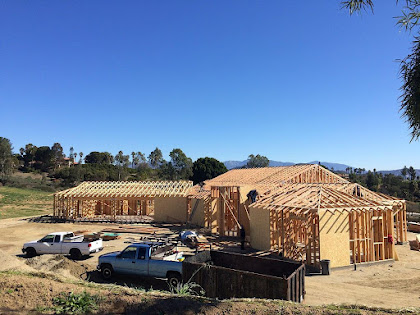Once
you have made the decision to use roof trusses to save time and money, it is
important to consider the process of installation. Trusses are generally dropped on site,
and the roof truss installation is performed by the builder. Because this is such an important component
of the building process, it is vital that builders understand the proper
procedures for truss installation.
1.
Site Preparation. Proper site preparation, including establishing precise
measurements and ensuring a level foundation, is essential for the successful
installation of roof trusses. This
should be performed well before truss delivery, and should be a consideration
long before the first work is ever performed on the foundation of the building.
2. Delivery Time and Date. Arranging to have trusses dropped off at a
particular time or date is one of the greatest advantages to using a truss
system. Truss manufacturers will usually
work with customers to find the ideal time and date for delivery, but be
prepared to be somewhat flexible as well.
3.
Handling and Lifting. Roof trusses are often large and cumbersome, requiring
specialized equipment and trained personnel for safe handling and lifting into
position. It is important to consider
workflow and how many people will be needed to install trusses on the day of
delivery in order to streamline the process and avoid having the trusses sit
for too long.
4.
Bracing and Temporary Support. Temporary bracing and support may be necessary
during truss installation to prevent lateral movement and ensure stability
until permanent connections are made.
This often necessitates the need for secondary lumber or other
structures which should be ready when trusses are delivered.
5.
Alignment and Spacing. Trusses must be aligned correctly and spaced according
to engineering specifications to ensure structural integrity and proper load
distribution. Your truss manufacturer
should provide these instructions to you, which should be followed to the
letter.
6.
Weather Protection. Trusses should be protected from exposure to moisture and
adverse weather conditions during installation to prevent damage to the
structural components. If your trusses
cannot be installed immediately upon delivery, plan to have a good place to
store them away from the elements and to protect them from vandalism or theft.
Roof
trusses play a vital role in modern building construction, providing efficient
structural support for roofs while offering advantages in cost, speed,
flexibility, and space optimization. By understanding the components, types,
advantages, and installation considerations of roof trusses, architects,
engineers, and builders can leverage this versatile building system to create
durable and aesthetically pleasing structures.
If you are considering Wood Truss Manufacturers in San
Diego, look no further than Stone Truss! When you search for “wood truss manufacturers
near me,” or “truss builders near me,” Stone Truss is the name you should
trust. Our years of experience allow us
to help you choose the right products to fit your time and budget. Give us a call today to learn more!




Comments
Post a Comment